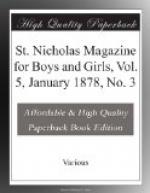[Illustration: A FANCY WHEELBARROW.]
For further particulars on wood-carving, see illustrated
articles in
ST. NICHOLAS, Vol. I., pp. 84, 215, 346, 592.
A SET OF TEA-NAPKINS.
There hardly could be a nicer gift for a girl to make for her mother or married sister than a set of tea-napkins, with a large initial letter in white, or white and red, embroidered on each. The doily should be folded in four, and the letter out-lined in lead pencil in the corner of one of the quarters. If inked very black on paper, and held dry to the window behind the linen, the initial is easily traced. The pattern is then run and “stuffed” with heavy working-cotton, and the letter embroidered in finer cotton. Another nice gift is a long fringed towel, with three very large letters in white, or blue, or crimson, worked half-way between the middle and the side edge. Folded over lengthwise, it is a convenient thing to lay on a bureau-top or the front of a sideboard, and the large colored letters make it ornamental as well. Patterns of initials can be bought in any fancy shop. If desired, they can be bought already worked, requiring only to be transferred to the napkin.
NAPKIN-BANDS.
Any of you who have mastered cross-stitch, and learned to follow a pattern, will find these bands easy enough to make. Their use is to fasten a napkin round a child’s neck at dinner, and take the place of that disobliging “pin,” which is never at hand when wanted. You must cut a strip of Java canvas, two inches wide by a foot long; overcast the edges, and work on it some easy little vine in worsted, or a Grecian pattern, or, if you like, a short motto, such as “More haste, worse speed.” Line the strip with silk, turn in the edges, overhand them, and finish the ends with two of those gilt clasps which are used to loop up ladies’ dresses.
A RUSTIC VASE.
[Illustration]
It is very easy to get the material out of which this vase is made. You need only go to your wood-pile, or, if you have none, to the wood-pile of a neighbor. Choose a round stick four inches in diameter and eight or ten inches long, with a smooth bark. If you find the stick, and it is too long, you can easily saw off an end. Now comes the difficult part of the work: The inside of the stick must be scooped out to within four inches of the bottom. The easiest way of accomplishing this will be to send it to a turning-mill if there is one at hand; if not, patience and a jack-knife will in the end prevail. Next, with a little oil-color, paint a pretty design on the bark, if you can,—trailing-arbutus, partridge berry, sprays of linnea,—any wood thing which can be supposed to cluster naturally round a stump. Set the stump in a flower-pot saucer, filled with earth, and planted with mosses and tiny




